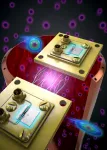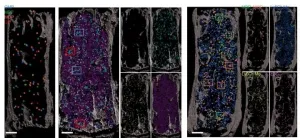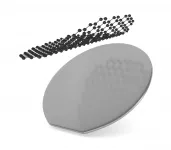(Press-News.org) For nearly a century, scientists have worked to unravel the mystery of dark matter--an elusive substance that spreads through the universe and likely makes up much of its mass, but has so far proven impossible to detect in experiments. Now, a team of researchers have used an innovative technique called "quantum squeezing" to dramatically speed up the search for one candidate for dark matter in the lab.
The findings, published today in the journal Nature, center on an incredibly lightweight and as-of-yet undiscovered particle called the axion. According to theory, axions are likely billions to trillions of times smaller than electrons and may have been created during the Big Bang in humungous numbers--enough to potentially explain the existence of dark matter.
Finding this promising particle, however, is a bit like looking for a single quantum needle in one really big haystack.
There may be some relief in sight. Researchers on a project called, fittingly, the Haloscope At Yale Sensitive To Axion Cold Dark Matter (HAYSTAC) experiment report that they've improved the efficiency of their hunt past a fundamental obstacle imposed by the laws of thermodynamics. The group includes scientists at JILA, a joint research institute of the University of Colorado Boulder and the National Institute of Standards and Technology (NIST).
"It's a doubling of the speed from what we were able to do before," said Kelly Backes, one of two lead authors of the new paper and a graduate student at Yale University.
The new approach allows researchers to better separate the incredibly faint signals of possible axions from the random noise that exists at extremely small scales in nature, sometimes called "quantum fluctuations." The team's chances of finding the axion over the next several years are still about as likely as winning the lottery, said study coauthor Konrad Lehnert, a NIST Fellow at JILA. But those odds are only going to get better.
"Once you have a way around quantum fluctuations, your path can just be made better and better," said Lehnert, also a professor adjoint in the Department of Physics at CU Boulder.
HAYSTAC is led by Yale and is a partnership with JILA and the University of California, Berkeley.
Quantum laws
Daniel Palken, the co-first author of the new paper, explained that what makes the axion so difficult to find is also what makes it such an ideal candidate for dark matter--it's lightweight, carries no electric charge and almost never interacts with normal matter.
"They don't have any of the properties that make a particle easy to detect," said Palken, who earned his PhD from JILA in 2020
But there's one silver lining: If axions pass through a strong enough magnetic field, a small number of them may transform into waves of light--and that's something that scientists can detect. Researchers have launched efforts to find those signals in powerful magnetic fields in space. The HAYSTAC experiment, however, is keeping its feet planted on Earth.
The project, which published its first findings in 2017, employs an ultra-cold facility on the Yale campus to create strong magnetic fields, then try to detect the signal of axions turning into light. It's not an easy search. Scientists have predicted that axions could exhibit an extremely wide range of theoretical masses, each of which would produce a signal at a different frequency of light in an experiment like HAYSTAC. In order to find the real particle, then, the team may have to rifle through a large range of possibilities--like tuning a radio to find a single, faint station.
"If you're trying to drill down to these really feeble signals, it could end up taking you thousands of years," Palken said.
Some of the biggest obstacles facing the team are the laws of quantum mechanics themselves--namely, the Heisenberg Uncertainty Principle, which limits how accurate scientists can be in their observations of particles. In this case, the team can't accurately measure two different properties of the light produced by axions at the same time.
The HAYSTAC team, however, has landed on a way to slip past those immutable laws.
Shifting uncertainties
The trick comes down to using a tool called a Josephson parametric amplifier. Scientists at JILA developed a way to use these small devices to "squeeze" the light they were getting from the HAYSTAC experiment.
Palken explained that the HAYSTAC team doesn't need to detect both properties of incoming light waves with precision--just one of them. Squeezing takes advantage of that by shifting uncertainties in measurements from one of those variables to another.
"Squeezing is just our way of manipulating the quantum mechanical vacuum to put ourselves in a position to measure one variable very well," Palken said. "If we tried to measure the other variable, we would find we would have very little precision."
To test out the method, the researchers did a trial run at Yale to look for the particle over a certain range of masses. They didn't find it, but the experiment took half the time that it usually would, Backes said.
"We did a 100-day data run," she said. "Normally, this paper would have taken us 200 days to complete, so we saved a third of a year, which is pretty incredible."
Lehnert added that the group is eager to push those bounds even farther--coming up with new ways to dig for that ever-elusive needle.
"There's a lot of meat left on the bone in just making the idea work better," he said.
INFORMATION:
What The Study Did: This observational study describes differences in the number of COVID-19 deaths by nursing home racial composition and examines the factors associated with these differences.
Authors: Rebecca J. Gorges, Ph.D., of the University of Chicago, is the corresponding author.
To access the embargoed study: Visit our For The Media website at this link https://media.jamanetwork.com/
(doi:10.1001/jamanetworkopen.2020.37431)
Editor's Note: The article includes funding/support disclosures. Please see the article for additional information, including other authors, author contributions and affiliations, conflict of interest ...
What The Study Did: This article revisits the role of dermatologists in the early HIV/AIDS epidemic for the 40th anniversary of the epidemic.
Authors: Heather Milbar, M.D., M.P.H., of the University of Pennsylvania in Philadelphia, is the corresponding author.
To access the embargoed study: Visit our For The Media website at this link https://media.jamanetwork.com/
(doi:10.1001/jamadermatol.2020.5545)
Editor's Note: Please see the article for additional information, including other authors, author contributions and affiliations, conflict of interest and financial disclosures, and funding and support.
INFORMATION:
Media ...
What The Study Did: Researchers examined changes in how organ donation from deceased donors differed by race and ethnicity in the United States over time.
Authors: Dorry L. Segev, M.D., Ph.D., of the Johns Hopkins University School of Medicine in Baltimore, is the corresponding author.
To access the embargoed study: Visit our For The Media website at this link https://media.jamanetwork.com/
(doi:10.1001/jamasurg.2020.7083)
Editor's Note: The article includes conflicts of interest and funding/support disclosures. Please see the article for additional information, including other authors, author contributions and affiliations, conflict of interest and financial disclosures, and funding and support.
INFORMATION:
Media advisory: The full study is linked to this news ...
Researchers in Southampton and San Francisco have developed the first compact 3D LiDAR imaging system that can match and exceed the performance and accuracy of most advanced, mechanical systems currently used.
3D LiDAR can provide accurate imaging and mapping for many applications; it is the "eyes" for autonomous cars and is used in facial recognition software and by autonomous robots and drones. Accurate imaging is essential for machines to map and interact with the physical world but the size and costs of the technology currently needed has limited LIDAR's use in ...
CINCINNATI--Imagine a day when clinicians treating people with blood diseases such as leukemia or multiple myeloma can send in requests for laboratories to custom-produce specific types of blood cells to replace those affected by the disease.
That day became one step closer to reality with a new study led by experts at Cincinnati Children's that provides powerful new insights into how bone marrow tissue works.
The study, published Feb. 10, 2021 in Nature, was led by senior author Daniel Lucas, PhD, and first authors Jizhou Zhang, MD, and Qingqing Wu, PhD, from the Division of Experimental Hematology and Cancer Biology. Co-authors include a team of scientists from Cincinnati Children's and the University of Cincinnati, plus collaborators in Colorado, Texas and Michigan.
The ...
Imaging planets orbiting around nearby stars, which could potentially harbour life, has become a possibility thanks to the progress made in observational methods by an international team of astronomers. First candidate: Alpha Centauri, a system similar to ours, "only" 4.3 light years away. This study is the subject of a publication in the journal Nature Communications.
Efforts to obtain direct images of exoplanets - planets outside our solar system - have so far been hampered by technological limitations, which have led to a bias towards detecting planets much larger than Jupiter, around very young stars and far from the habitable zone, the area in which a planet may have liquid water on its surface, and thus ...
Researchers from the University of Seville's Nursing Department, with the collaboration of professionals from the ICU at Virgen Macarena University Hospital in Seville, have analysed the key factors in caring for critical COVID-19 patients during the first wave of the pandemic. Their study concludes that nursing care was impacted by fear and isolation, which made it difficult to maintain the human experience of health care.
The break down in the humanising trend of ICU care during this period was mainly the result of the isolation of COVID-19 patients. This, along with the personal protection equipment worn by staff to prevent becoming infected ...
10,000 km2 of ice disappeared in a blink of an eye from an ice sheet in the Storfjorden Through offshore Svalbard, a new study shows. This dramatic break off was preceded by quite a rapid melt of 2.5 kilometres of ice a year. This parallels the current melt rates in Antarctica and Greenland and worries the scientists behind the study.
"Our measurements of the ice retreat in Storfjorden Through show that the prevailing conditions to the great break off, match what we see in Antarctica and Greenland today. It is uncanny. There are new studies published almost weekly, that show that the retreat of current ice sheets is two to four km a year and that it's speeding up." Says CAGE-professor and first author Tine Lander Rasmussen.
Climatically unstable period
The last deglaciation, ...
Two-dimensional (2D) materials have a huge potential for providing devices with much smaller size and extended functionalities with respect to what can be achieved with today's silicon technologies. But to exploit this potential we must be able to integrate 2D materials into semiconductor manufacturing lines - a notoriously difficult step. A team of Graphene Flagship researchers in Sweden and Germany now reports a new method to make this work.
The technique, just published in Nature Communications by researchers from Graphene Flagship partners RWTH Aachen University, Universität der Bundeswehr ...
New research from Trinity College Dublin suggests that older adults can be more focused, less impeded by anxiety and less mentally restless than younger adults. The team at the Trinity College Institute of Neuroscience (TCIN) (today, Wednesday, 10th February, 2021) show that older adults appear to mitigate the negative aspects of cognitive decline by increasing motivation and adopting more efficient strategies to suspend the wandering mind when focus is required.
The study, published in the journal Psychology and Aging (American Psychological Association) is the first to adjudicate between competing theories of age-related ...




